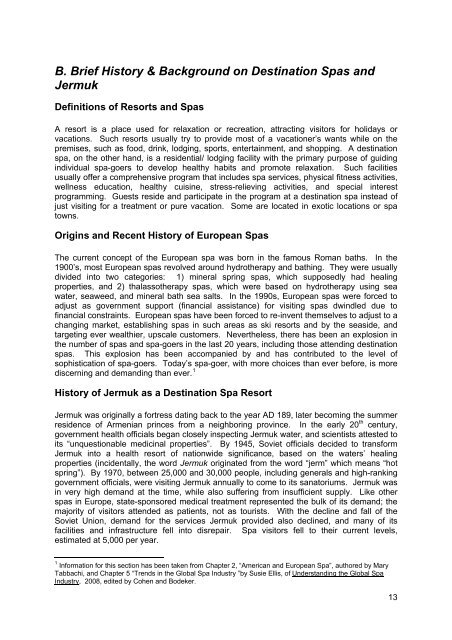Core Strategy: Jermuk as a Tourism Destination - CAPS
Core Strategy: Jermuk as a Tourism Destination - CAPS
Core Strategy: Jermuk as a Tourism Destination - CAPS
You also want an ePaper? Increase the reach of your titles
YUMPU automatically turns print PDFs into web optimized ePapers that Google loves.
B. Brief History & Background on <strong>Destination</strong> Sp<strong>as</strong> and<br />
<strong>Jermuk</strong><br />
Definitions of Resorts and Sp<strong>as</strong><br />
A resort is a place used for relaxation or recreation, attracting visitors for holidays or<br />
vacations. Such resorts usually try to provide most of a vacationer’s wants while on the<br />
premises, such <strong>as</strong> food, drink, lodging, sports, entertainment, and shopping. A destination<br />
spa, on the other hand, is a residential/ lodging facility with the primary purpose of guiding<br />
individual spa-goers to develop healthy habits and promote relaxation. Such facilities<br />
usually offer a comprehensive program that includes spa services, physical fitness activities,<br />
wellness education, healthy cuisine, stress-relieving activities, and special interest<br />
programming. Guests reside and participate in the program at a destination spa instead of<br />
just visiting for a treatment or pure vacation. Some are located in exotic locations or spa<br />
towns.<br />
Origins and Recent History of European Sp<strong>as</strong><br />
The current concept of the European spa w<strong>as</strong> born in the famous Roman baths. In the<br />
1900’s, most European sp<strong>as</strong> revolved around hydrotherapy and bathing. They were usually<br />
divided into two categories: 1) mineral spring sp<strong>as</strong>, which supposedly had healing<br />
properties, and 2) thal<strong>as</strong>sotherapy sp<strong>as</strong>, which were b<strong>as</strong>ed on hydrotherapy using sea<br />
water, seaweed, and mineral bath sea salts. In the 1990s, European sp<strong>as</strong> were forced to<br />
adjust <strong>as</strong> government support (financial <strong>as</strong>sistance) for visiting sp<strong>as</strong> dwindled due to<br />
financial constraints. European sp<strong>as</strong> have been forced to re-invent themselves to adjust to a<br />
changing market, establishing sp<strong>as</strong> in such are<strong>as</strong> <strong>as</strong> ski resorts and by the se<strong>as</strong>ide, and<br />
targeting ever wealthier, upscale customers. Nevertheless, there h<strong>as</strong> been an explosion in<br />
the number of sp<strong>as</strong> and spa-goers in the l<strong>as</strong>t 20 years, including those attending destination<br />
sp<strong>as</strong>. This explosion h<strong>as</strong> been accompanied by and h<strong>as</strong> contributed to the level of<br />
sophistication of spa-goers. Today’s spa-goer, with more choices than ever before, is more<br />
discerning and demanding than ever. 1<br />
History of <strong>Jermuk</strong> <strong>as</strong> a <strong>Destination</strong> Spa Resort<br />
<strong>Jermuk</strong> w<strong>as</strong> originally a fortress dating back to the year AD 189, later becoming the summer<br />
residence of Armenian princes from a neighboring province. In the early 20 th century,<br />
government health officials began closely inspecting <strong>Jermuk</strong> water, and scientists attested to<br />
its “unquestionable medicinal properties”. By 1945, Soviet officials decided to transform<br />
<strong>Jermuk</strong> into a health resort of nationwide significance, b<strong>as</strong>ed on the waters’ healing<br />
properties (incidentally, the word <strong>Jermuk</strong> originated from the word “jerm” which means “hot<br />
spring”). By 1970, between 25,000 and 30,000 people, including generals and high-ranking<br />
government officials, were visiting <strong>Jermuk</strong> annually to come to its sanatoriums. <strong>Jermuk</strong> w<strong>as</strong><br />
in very high demand at the time, while also suffering from insufficient supply. Like other<br />
sp<strong>as</strong> in Europe, state-sponsored medical treatment represented the bulk of its demand; the<br />
majority of visitors attended <strong>as</strong> patients, not <strong>as</strong> tourists. With the decline and fall of the<br />
Soviet Union, demand for the services <strong>Jermuk</strong> provided also declined, and many of its<br />
facilities and infr<strong>as</strong>tructure fell into disrepair. Spa visitors fell to their current levels,<br />
estimated at 5,000 per year.<br />
1 Information for this section h<strong>as</strong> been taken from Chapter 2, “American and European Spa”, authored by Mary<br />
Tabbachi, and Chapter 5 “Trends in the Global Spa Industry ”by Susie Ellis, of Understanding the Global Spa<br />
Industry, 2008, edited by Cohen and Bodeker.<br />
13



